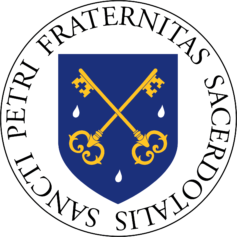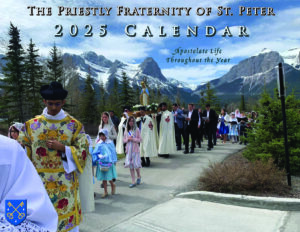Holy Thursday at OLGS – Photo Gallery
The following pictures were taken at the Mass of Holy Thursday at Our Lady of Guadalupe Seminary’s newly consecrated chapel.















May 5, 2010

2010 Easter Vigil at OLGS – Photo Gallery (Set 2)
Second set of photos from the Easter Vigil celebrated in our newly consecrated chapel at Our Lady of Guadalupe Seminary in Denton, Nebraska.















May 3, 2010

2010 Easter Vigil at OLGS – Photo Gallery (Set 1)
Photos from the Easter Vigil celebrated in our newly consecrated chapel at Our Lady of Guadalupe Seminary in Denton, Nebraska.












May Reflection on Our Lady
by Fr. Eric Flood, FSSP, District Superior
St. James tells us that “every perfect gift is from above, coming down from the Father.” Primarily this passage refers to the Incarnation, yet, secondarily it refers to the Blessed Virgin Mary for she is a perfect gift whom we have received from God. Her sinless life gives each of us the ideal to strive for, and as our heavenly mother, she is the model and standard for all mothers.

We are not surprised that those who live too much in the world attack the Blessed Virgin Mary, for her image of motherhood threatens the current standard that measures success by a paycheck at the end of the week. Consequently, as our society puts everything in dollar amounts, women are pressured to limit the number of children they bear, but this only blurs the understanding of motherhood and deteriorates the respect owed to the femininity in the heart of a woman. To put this another way, by bearing children, a wife not only gains the title of “mother,” but also brings to fruition her inmost femininity. Our Lady also shows that the dignity of women is founded upon their unique gift of bearing children, for her greatest title is that of Mother of God.
The world still has a glimmer of the importance of bringing children into the world by celebrating Mothers’ Day. Normally, the world focuses on remembering our mother this day with a card and gift, but the corollary to the celebration of this day is that it thanks her for her willingness to conceive children. As a result, it is a day in which we not only thank God for all the matriarchs of our family but also for the passing on to us of our Catholic Faith. We know that Our Lord has instituted marriage primarily for the begetting of children, so how blessed are the mothers who have fulfilled God’s plan of perpetuating the human race within the context of holy matrimony. It is a day we celebrate a wife becoming a mother, and we extol her glory in the unique privilege bestowed upon her by Almighty God. With this in mind, Pope John Paul II reminds us that “The mentality which honors women more for their work outside the home than for their work within the family must be overcome” (Familiaris Consortio, #23).
We turn to the Blessed Virgin Mary in this month dedicated to her for the example of the perfect mother. These past decades, some have tried to redefine the role of women in the world, so we always have to go back to the perfect woman whom God has placed in the world to make sure we have not strayed from the truth. We find that as women are seeking to be liberated in this age, Our Lady is still the standard for all truly liberated women. She is the only woman who has been free of the shackles of sin, free of oppression, and free of being dominated. For it is the world and the devil which oppresses, dominates, and puts us into chains, and it is Our Lady who crushes these foes beneath her heel. We note how the world has turned liberation around from being free of sin to having license to sin. In her freedom, the Blessed Virgin Mary finds complete joy and fulfillment by being a mother. Like Our Lady who crushes the head of the devil, among the various duties of a mother is to keep her children safe from the evils of the world. For God expects mothers to watch over and protect her children, to nurture and educate her children, and to give her life as a sacrifice for her children.
It is the duty of a mother to watch over and to protect her household. For a mother must consider it of prime importance to watch over the home and to never allow disrespect or disobedience to go unpunished. Her eagle eye must pay close attention to her children from their youth and especially in their teenage years. If she declines to reprimand them as children and to let them have their way as adolescents, then her children will lose respect for her, for motherhood, and for the dignity of women in general. On the other hand, if children perceive that they are disciplined because they are loved, the daughter will grow up with her mother as a role model, and the son will respect his future wife since he has learned the great value of women through his mother.
Whereas, no one likes to be unpopular with children, discipline will be required at times, and the greatest challenge will be to discipline consistently. There is assistance for mothers to discipline correctly and it stems from her second duty; that is, to nourish and educate her children. If every day a young man visited the home of a young lady, the woman would understand that she has gained the affections of the young man. And if every day, a mother shows loving affection towards a child, the child will understand that he is the object of his mother’s affections, and that she truly cares for him, even when he has to be disciplined. The child will realize that to violate his mother’s love will be to violate his very self. If, at times, he is disrespectful, he will soon acknowledge his fault, beg God for forgiveness, and understand that his mother has already forgiven him.
This will only occur if the mother has also fulfilled her essential duty of teaching her children about God and the world. For this reason more and more mothers have difficulties handing their children over to the public educational system which neglects Catholic morality and the understanding of God’s continual interaction in the history of mankind. A Catholic mother, on the other hand, will ensure that her children receive an education centered on the truths of our Faith, then on all other subjects. By doing so, the child is taught that God comes first to all other things, even over money, entertainment, and sports. The example of the mother is also of grave importance to the education of the child. People aren’t too surprised when an undisciplined mother has children who lack virtue, and St. John Vianney says, virtue quickly passes from the heart of a mother into her children.
But the demands of motherhood are great and seemingly endless. To counteract this life of hardship, the world tells mothers to take plenty of rest and to do fun things apart from the children. But this often produces uneasiness in the hearts of mothers whose enjoyment is to be around their families. So instead of dwelling upon the demands of motherhood and becoming dismayed, it is better to be inspired by its rewards. The reward of fulfilling her motherly duties in a loving manner will not reap immediate results, but the reward of a Catholic mother begins when they grow up and live virtuous lives. At this time they will be like trophies to the world, showing off the accomplishments of a good mother. The greatest joy will be her knowing that they will continue to pray for her when she dies, and that they will one day join her in Heaven.
So mothers have Our Lady in Heaven for their guidance and assistance. She will assist you in raising your children, but motherhood requires that you speak to Our Lady from your heart, as you would your own mother. The Blessed Virgin Mary, in turn, will also enlighten you to become more like her, and how wonderful it is when children learn about their heavenly mother through the life of their earthly mother.
This article originally appeared in the May 2008 edition of the North American District Fraternity Newsletter. To receive our free newsletter by mail, please visit our subscription page.
May 1, 2010

2010 Easter Sunday Vespers at OLGS – Photo Gallery
The following are photos of our Easter Sunday Vespers from Our Lady of Guadalupe Seminary in Denton, Nebraska.






April 29, 2010

Chartres Pilgrimage 2010
If you are having trouble viewing the video, please go here: 2010 Chartres Pilgrimage (English) for more information.
From the Pilgrimage Website:
May 22nd, 23rd and 24th 2010
28th Paris to Chartres Pilgrimage
THE CHURCH IS OUR MOTHER
The Paris-Chartres Pilgrimage is a three-day walk from Notre-Dame de Paris to Notre-Dame de Chartres, approximately 75 miles. Pilgrims are organized into groups of 20-65 people, that are referred to as “chapters”. The “walk” is through the streets of Paris, and then into the countryside. It can be muddy, rocky, and demanding-and the rewards of such a penitential exercise are eternal. Good sturdy shoes are a must. Each chapter is accompanied by at least one chaplain, who hears confession and gives spiritual direction to each pilgrim who avails himself of the priest’s presence. This pilgrimage originated in the 12th century, with interruptions for the various wars our European brethren seem to find themselves in from time to time. A plenary indulgence is granted, under the usual conditions. Pilgrims will meet in front of Notre Dame de Paris at 6 a.m. on May 22nd, and the journey of faith and foot begins.

April 8, 2010

Chapel Consecration Now on DVD
 On March 3, 2010, the new chapel for Our Lady of Guadalupe Seminary was consecrated by His Excellency Bishop Fabian Bruskewitz, Bishop of Lincoln, Nebraska – in the presence of His Eminence William Cardinal Levada, Prefect for the Congregation of the Doctrine of the Faith – along with several co-consecrators.
On March 3, 2010, the new chapel for Our Lady of Guadalupe Seminary was consecrated by His Excellency Bishop Fabian Bruskewitz, Bishop of Lincoln, Nebraska – in the presence of His Eminence William Cardinal Levada, Prefect for the Congregation of the Doctrine of the Faith – along with several co-consecrators.
A 2-DVD set, in NTSC# Region 0 format, is now available of the consecration ceremony and Pontifical Mass which followed. With commentary by Rev. Calvin Goodwin, FSSP and Rev. Justin Nolan, FSSP, recapture the beauty and solemnity of the consecration of heart and jewel of the seminary.
Running time is 4.5 hours. Price includes shipping/handling cost.‡
$25 U.S. orders
$32 Int’l. orders†
# – NTSC, Region 0 will work on all TV DVD players in the U.S. Please check your DVD if you are outside the U.S. to confirm player compatability. This format will play all computer DVD players, even outside the U.S.
‡ – Price is adjusted in the Amazon store at checkout to reflect final DVD cost plus shipping/handling.
† – Due to an Amazon limitation on international shipping costs beyond our control, an international order will total $34.31. We will automatically process a rebate, when an international order ships, in the amount of $2.31 so that the final credit card amount charged will be $32.00. We apologize for any inconvenience this may cause for international orders.
April 6, 2010

The Priest and the Mass
By Fr. Eric Flood, FSSP – District Superior
We read in the Book of Genesis that the sons of Adam offered gifts to the Lord, that Abel’s sacrifice of an animal, most probably a lamb, was acceptable to God, but Cain’s offering of food was not. From this, we gather that God is specific about which offerings are pleasing to Him, and will reject them otherwise. So it is that during the Canon of every Latin Mass we ask God to accept the Sacrifice upon our Altar as He once accepted the sacrifice of Abel.

It is reasonable to assume that Adam had taught his sons about the value of sacrificing an animal to God in atonement for sin. Adam himself learned the importance of offering a bloody sacrifice in atonement for sin when God gave him the skins of animals to wear after committing the Original Sin. As Archbishop Fulton Sheen puts it, “In order for God to give Adam the skins of an animal to wear, an animal had to be killed…the blood of the animal had to be spilled.” We further read in the Holy Bible that every generation from Adam to Christ offered such sacrifices to God: Moses, Abraham, King David, and eventually every Jewish family would bring a lamb to the Temple in atonement for the sins of the past year. The historian Josephus tells us that at the time of Christ, 300,000 lambs were killed each year on the Day of Atonement. For nearly four thousand years, all of creation waited in expectation for the Blood of Christ to be sacrificed upon the Cross as a perfect sacrifice in expiation of our sins.
We hear how Herod tried to act as a priest by attempting to spill the Blood of Christ by the slaughter of the Innocents, but it was Christ who sacrificed His own Blood since He is the perfect Priest who offers the perfect Sacrifice of Himself. He now continues to give us His perfect Sacrifice in the Holy Eucharist. It is the treasure entrusted only to human beings to receive: Angels can’t receive Holy Communion; Angels can’t say Mass; animals have been known to bow down in front of the Blessed Sacrament, but they cannot receive It. Only human beings can receive Our Blessed Lord, yet it has to be done with the greatest reverence and with the most attention we can give to God.
And to prevent any human innovations in liturgy during Old Testament times, God gave Moses many rubrics on how to offer a sacrifice, who can offer a sacrifice, and what can be sacrificed. The violation of the ordinances of God could be punishable by death, but over time, as the interior life of the priests was lessened, there was a shift to an over-emphasis of the exterior rubrics and practices. In order to combat the rubrical exactness of the Pharisees, Our Lord taught the Apostles how to say Mass only after three years of their growing in virtue and understanding of the perfect teachings of Christ. Thus, the Church has continued to keep guard and form its priests who offer the perfect Sacrifice, and how It is to be offered.
We are given a greater insight into the various roles and expectations of the priest who approaches the Altar to say Holy Mass by observing the various vestments he is clothed with. The first garment the priest puts on is the amice. It is a rectangular piece of linen which he first touches to his head, then wraps around his neck. It used to be that the amice was worn around the head, as it symbolizes a helmet, but with the introduction of the biretta, the amice is now only wrapped around the neck after being touched to the top of the head. The amice is a symbol of a helmet because the priest is in a battle, not just in his daily life by fighting against sin, but against the devils as Holy Mass is the greatest weapon to fight them.
After the amice, the priest vests with a white alb to indicate the purity and innocence he must have when saying Mass. Thus, the daily life of a priest is the occasion for his growth in the virtues necessary to stand before God at the Altar, and his entire day is viewed as a preparation for the next Mass he will soon say.
The next vestment the priest is clothed in is called the cincture. It is a cord wrapped around his waist, and it represents the chastity and continence required of a priest to be in persona Christi (in the person of Christ). It is a symbol that the priest will not marry in imitation of Christ, who was perfectly chaste but bound to the Cross with cords of rope.
The priest then dons the maniple and wears it over the left arm to symbolize the labor and hardship he must accept in his arduous daily duties. Then, the priest is clothed with the stole worn around the neck and crossed over the chest in the form of the cross. The stole shows that he is invested with the authority of God to engage in priestly action. Thus, whenever a priest celebrates a Sacrament, blesses an object, or does a priestly action, he wears the stole. Lastly, the priest puts on the chasuble, which symbolizes the charity or unselfish motives he is to have in serving the Lord in all his actions.
And having been vested with purity, innocence, chastity, hard labor, and charity throughout his daily life, the priest is now ready to ascend to the Altar according to the requirements of God and His Church. In his May 24 interview, His Eminence Darío Cardinal Castrillón Hoyos said that in the priesthood there should be nothing other than a humble fidelity in the liturgy to what Christ, the high Priest, does at the Altar. Oftentimes during my travels, people will approach me after Mass and say how beautiful and reverent the Latin Mass is, to which I respond, anything God has designed has to be so.
In the same interview, His Eminence mentioned the goals of the Holy Father to have the powerful force of the Old Rite of Mass celebrated once a week in most parishes. We know this goal will take much time to implement, yet the response to the motu proprio “Summorum Pontificum” has been tremendous in North America. In 2008 the Fraternity of St. Peter was able to open new apostolates in Dayton, Ohio and Fort Wayne, Indiana; Joliet, Illinois; Quincy, Illinois; and Seattle, Washington. Many other dioceses have opened their doors to the Fraternity, and in time we hope to fulfill their needs.
Also during the interview of Cardinal Castrillón Hoyos, he was asked if there would be the possibility of amalgamating the Old Rite of Mass with the New Rite. His Eminence responded that he did not think so, since they are different. He further said that it is hoped that the Latin Mass would help eliminate the abuses in the ordinary form of the Mass. It is encouraging to hear the expectations of Rome toward the Latin Mass and its future. We can only pour forth our prayers of thanksgiving to the Blessed Trinity and to the Saints in the halls of Heaven.
This article originally appeared in the August 2008 North American District Fraternity Newsletter.
March 30, 2010

The Holy Cross
by Fr. Eric Flood, FSSP – District Superior
 In the construction of a Catholic church, the symbol of the cross is a central theme throughout the architecture and furnishings as it is the Christian sign of our salvation. The great altar of sacrifice is adorned with an altar cross: that is, a crucifix with the image of Our Lord affixed to it. When a church is consecrated, it has twelve crosses placed on the walls of the church to be anointed with sacred chrism. The vestments of chasuble, stole, maniple, and amice each have a cross sewn into them; the Stations of the Cross are to have wooden crosses attached to them; and the mensa (table) of the altar has five crosses cut into it. Furthermore, in each of the seven Sacraments, the Sign of the Cross is mandatory, and the Sign of the Cross is made over 50 times in the Mass itself.
In the construction of a Catholic church, the symbol of the cross is a central theme throughout the architecture and furnishings as it is the Christian sign of our salvation. The great altar of sacrifice is adorned with an altar cross: that is, a crucifix with the image of Our Lord affixed to it. When a church is consecrated, it has twelve crosses placed on the walls of the church to be anointed with sacred chrism. The vestments of chasuble, stole, maniple, and amice each have a cross sewn into them; the Stations of the Cross are to have wooden crosses attached to them; and the mensa (table) of the altar has five crosses cut into it. Furthermore, in each of the seven Sacraments, the Sign of the Cross is mandatory, and the Sign of the Cross is made over 50 times in the Mass itself.
Catholics in the first century began to make the Sign of the Cross on their forehead when beginning new tasks of the day or when praying. Over time, the Sign of the Cross was made over various parts of the body with particular intentions, and eventually, these Signs of the Cross were united in one large sign as we make now.
Divine Providence also augmented the importance of the Cross when Maxentius invaded Rome in the fourth century. In order to protect Rome, Emperor Constantine waged war against Maxentius, and one day, the Emperor saw a luminous cross in the sky with the words, “in this conquer.” The next night while he slept, he saw the same cross along with Christ appearing with it, who admonished him to place the Cross as his guide. It was under the glorious banner of the Cross that Constantine overcame his adversary in the year 312. The Cross then became an object of devotion to the Emperor, and soon, criminals were no longer inflicted with crucifixion as a punishment.
In the year 326, the mother of Constantine, St. Helena, who was about 80 years old, went to Jerusalem to excavate the dirt around the place where the tomb of Our Lord was supposed to be. It was after the death of Our Lord that the Jewish leaders had hidden the Cross in a ditch or well, and covered it over with stones so that Catholics would not find it and venerate it. By the fourth century, only a chosen few among the Jews knew the spot where it was hidden. It happened that one of them by the name of Judas, touched by Divine inspiration, pointed it out to the excavators. Later this Judas became a Catholic saint and is honored under the name of Cyriacus.
During the excavation, three crosses were found, and in order to determine which was the Cross Christ died upon, it was touched to a dead man by St. Helena, and the man came back to life. St. Helena and Constantine then built a magnificent basilica on the spot the Cross was found and placed the True Cross in it. That basilica is the site of the Church of the Holy Sepulchre which exists today. This began the Feast of the Finding of the Cross which we celebrate on May 3.
When the Persian king, Chosroes II, invaded Jerusalem in the year 614, after he killed thousands of Catholics, he took the Cross which St. Helena had found. In retaliation, the Roman Emperor Heraclius engaged in a war against Chosroes, but he was overwhelmed with many misfortunes and defeat. When he tried to negotiate for peace, Chosroes would not consider it. As a result, Emperor Heraclius began to pray, fast, and implore God’s assistance. He then formed an army and eventually overcame Chosroes. When Chosroes was fleeing Rome, he was about to cross the Tigris River and he proclaimed one of his sons to be his successor. However, his older son, being jealous of his younger brother being named king, murdered his father and brother and was made king.
Emperor Heraclius then demanded that the new king return the Cross of Christ which left Jerusalem fourteen years earlier. In order to have a solemn entry of the Cross into Jerusalem, the Emperor Heraclius decided to carry it on his own shoulders in imitation of Christ. He was dressed in kingly apparel, but when he was leaving the gates of Jerusalem, he came to a halt and could not move. It was then that the Bishop of Jerusalem cried out: “O Emperor, you are trying to imitate Christ when He carried the Cross, but Christ was not dressed in rich garments, but poor ones.” So the Emperor removed his royal robe, put on a rough garment, and was then able to easily carry the Cross up to Calvary. It was this day, September 14, 629, that we celebrate annually in the traditional calendar, the Exaltation of the Holy Cross.
Once St. Helena found the Cross, public adoration of it began to grow, most especially on the day remembering the death of Christ—Good Friday. Even to this day, it is part of the Good Friday liturgy to kiss the feet of the Crucified Lord. In the fifth and sixth centuries, artists began to make the Cross as elaborate as they could by putting flowers, palms, and leaves sprouting from the root of the cross itself. As a living tree has life in it and gives life to its fruit, so too, life should be shown as springing from the new Tree of Life.
It was not until the sixth century that the figure of Christ appeared on the Cross. For up to this time, death by crucifixion was still vivid in those who lived in the Roman Empire. Thus, there was still a shame attached to such a death, and the Christians did not display the corpus of Christ out of respect for Him. Initially, the body of Christ displayed no signs of suffering, but in the tenth century, art took on a realistic tone, and the pain of the Cross began to appear on the body of Christ. And for the last millennium, devotion to the Crucifix has increased amidst persecutions, revolts, and governmental intervention to prevent it.
We too should follow the Catholic custom of having the Crucifix hanging on the walls of our home, for we will then be frequently reminded of how much Our Lord loves us.









